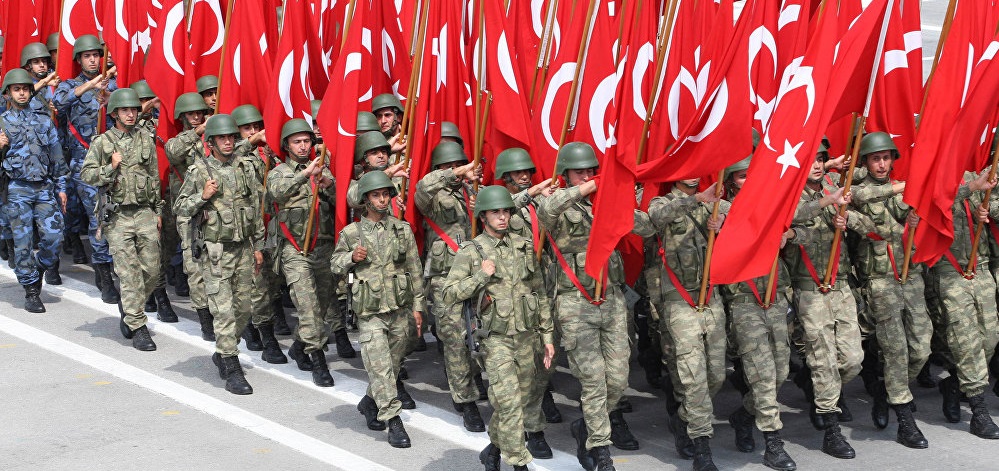
RNA - The opening phase of the force is planned to be launched by the four countries of Turkey, Azerbaijan, Kyrgyzstan, and Mongolia, with the duty to guard the regional security similar to the United Nations peace-keeping forces, sources familiar with its agenda have said.
Turkey’s role in the new regional military force is standing out well. Sources have noted that Turkey will undertake training of the multinational forces, as it is said will also lead the Turkic army.
Neo-Ottoman ambitions
What catches the attention about the force is it nearly ethnic nature. The majority of the participating nations in the Eurasian military bloc are Turkic ethnically. The main founding nations like Turkey and Azerbaijan are fully Turkic nations. Other participants such as Kyrgyzstan and Mongolia have major Turkic population. However, Turkey is looking at the whole of Eurasia region as its traditional sphere of influence, or what some analysts call the “historical Turkey.” The Ankara leaders are now striving to revive their identity-based bonds with the Central Asia region based on a background of the Turkic ethnicity.
The fact is that Turkey at the current time, and especially after the last year’s constitutional reform referendum that gave President Recep Tayyip Erdogan much greater power at home, has pursued a policy of foisting a sort of Turkish hegemony on the region using various tools in this course. This regional hegemonization is part of a broader neo-Ottoman ambition pursued by Erdogan since he rose to power in 2003. Building a presidential palace with Ottoman architecture, holding the diplomatic reception for the foreign leaders by soldiers wearing Ottoman-era uniforms, and making tens of splendorous movies on the history of the Ottoman sultans all bear witness to the Turkish leaders’ neo-Ottomanism.
This agenda went on with a more conservative course with Ahmet Davutoglu. Served from 2009 to 2014 as the Turkish foreign minister and from 2014 to 2015 as prime minister, Davutoglu was the architect of “strategic depth” theory which recommended the Turkish leaders to work towards zero-tension relations with the neighbors to reach the strategic depth. But the theory did not last for a long time. After Davutoglu’s resignation and reforming the constitution that dramatically solidified the power of Erdogan, the zero-tension policy counted almost for nothing with Erdogan policy, though he is still focusing on obtaining strategic depth and leading a regional hegemony. He draws on various, and many of them challenging, policies even if it takes flexing the muscles for other actors through leading a joint military force in Eurasia.
Eurasian force and regional challenges
Turkey is pressing for forging its own military force in Eurasia while there are already standing regional security and military alliances.
Both Mongolia and Kyrgyzstan are members of the Shanghai Cooperation Organization, a weighty regional bloc spearheaded by China and Russia. Now, this bloc stands as the most important regional body in Central Asia, and it seems that rise of a new organization, especially a military one, out of the body of the SCO will draw reactions of the organization’s key members. By taking Kyrgyzstan in the bloc, Turkey will directly step in Russia’s backyard. And by taking in Mongolia, Turkey will expand its area of influence next to the Great Wall of China. It will not be abnormal if China and Russia will not take approach positively a military force in their traditional areas of influence, nor is it surprising if the two powers rise in objection to this alliance.
On the other side, the idea of the military bloc comes while Turkey is itself a member state of NATO. The fact that a NATO member wants to set up its own military bloc out of the Western alliance’s body will not send a friendly message to the North Atlantic Treaty Organization. In fact, while the NATO is the icon of the West’s military alliance with Ankara, Turkey’s regional army will not send signals of intimacy to the West. Although in past few years Turkey became well disappointed with the Western alliance and its leaders’ anti-Western blasting tone echoed the tone of a country hostile to the West, the new Eurasian force is Erdogan’s newest message of frustration with West and NATO.
Moreover, the Turkish-led force in Central Asia is a double-edged blade for the West. Despite the fact that the alliance is a dispiriting message from Turkey to the NATO, the Europeans and Americans are not unhappy to see Turkey countering China and Russia as the West’s traditional rivals in Central Asia.
However, the former records show that Erdogan is smart and wary enough not to fall as a tool in the hands of the West. This means he will very likely not allow the US to exploit the Eurasian alliance for its own interests and against China and Russia in the region.
With this in mind, how will the Turkish-led military alliance possibly look like?
An alliance independent of East and West
Having in mind that Turkey knows that, on the one hand, the Russian and Chinese approach to the new force will never be congratulatory and, on the other hand, NATO will read the move a discouraging message, Ankara is building the force to raise its own independent bloc.
A bloc independent of both Moscow and Washington can be read as an Erdogan’s neo-Ottoman step amid viewing Turkey as an influential force on the regional and perhaps global stage. In this case, the Eurasian army will move Ankara one step closer to the realization of neo-Ottoman Turkey dreams.
Source: Alwaght
847/940